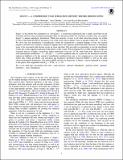| dc.contributor.author | Webster, David | |
| dc.contributor.author | Bland-Hawthorn, Joss | |
| dc.contributor.author | Frebel, Anna L. | |
| dc.date.accessioned | 2016-05-25T00:39:05Z | |
| dc.date.available | 2016-05-25T00:39:05Z | |
| dc.date.issued | 2016-02 | |
| dc.date.submitted | 2015-09 | |
| dc.identifier.issn | 1538-4357 | |
| dc.identifier.issn | 0004-637X | |
| dc.identifier.uri | http://hdl.handle.net/1721.1/102673 | |
| dc.description.abstract | Segue 1 is the current best candidate for a "first galaxy," a system that experienced only a single, short burst of star formation and has since remained unchanged. Here we present possible star formation scenarios that can explain Segue 1's unique metallicity distribution. While the majority of stars in all other ultra-faint dwarfs are within 0.5 dex of the mean [Fe/H] for the galaxy, five of the seven stars in Segue 1 have a spread of Δ[Fe/H] > 0.8 dex. We show that this distribution of metallicities cannot be explained by a gradual buildup of stars, but instead requires clustered star formation. Chemical tagging allows the separate unresolved delta functions in abundance space to be associated with discrete events in space and time. This provides an opportunity to put the enrichment events into a time sequence and unravel the history of the system. We investigate two possible scenarios for the star formation history of Segue 1 using Fyris Alpha simulations of gas in a 10[superscript 7] M[subscript ⊙] dark matter halo. The lack of stars with intermediate metallicities −3 < [Fe/H] < −2 can be explained either by a pause in star formation caused by supernova feedback or by the spread of metallicities resulting from one or two supernovae in a low-mass dark matter halo. Either possibility can reproduce the metallicity distribution function (MDF) as well as the other observed elemental abundances. The unusual MDF and the low luminosity of Segue 1 can be explained by it being a first galaxy that originated with M[subscript vir] ~ 10[superscript 7]M[subscript ⊙] at z ~ 10. | en_US |
| dc.description.sponsorship | National Science Foundation (U.S.) (Grant AST-1255160) | en_US |
| dc.description.sponsorship | National Science Foundation (U.S.) (Grant NSF PHY11-25915) | en_US |
| dc.language.iso | en_US | |
| dc.publisher | IOP Publishing | en_US |
| dc.relation.isversionof | http://dx.doi.org/10.3847/0004-637x/818/1/80 | en_US |
| dc.rights | Article is made available in accordance with the publisher's policy and may be subject to US copyright law. Please refer to the publisher's site for terms of use. | en_US |
| dc.source | IOP Publishing | en_US |
| dc.title | SEGUE 1—A COMPRESSED STAR FORMATION HISTORY BEFORE REIONIZATION | en_US |
| dc.type | Article | en_US |
| dc.identifier.citation | Webster, David, Anna Frebel, and Joss Bland-Hawthorn. “SEGUE 1—A COMPRESSED STAR FORMATION HISTORY BEFORE REIONIZATION.” The Astrophysical Journal 818, no. 1 (February 9, 2016): 80. © 2016 The American Astronomical Society | en_US |
| dc.contributor.department | Massachusetts Institute of Technology. Department of Physics | en_US |
| dc.contributor.department | MIT Kavli Institute for Astrophysics and Space Research | en_US |
| dc.contributor.mitauthor | Frebel, Anna L. | en_US |
| dc.relation.journal | The Astrophysical Journal | en_US |
| dc.eprint.version | Final published version | en_US |
| dc.type.uri | http://purl.org/eprint/type/JournalArticle | en_US |
| eprint.status | http://purl.org/eprint/status/PeerReviewed | en_US |
| dspace.orderedauthors | Webster, David; Frebel, Anna; Bland-Hawthorn, Joss | en_US |
| dspace.embargo.terms | N | en_US |
| dc.identifier.orcid | https://orcid.org/0000-0002-2139-7145 | |
| mit.license | PUBLISHER_POLICY | en_US |
| mit.metadata.status | Complete | |
